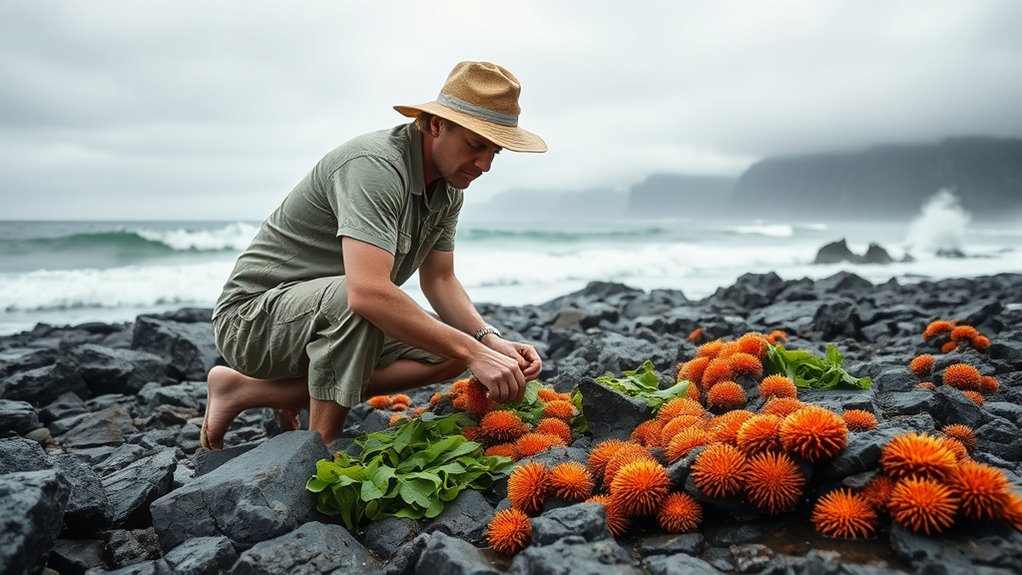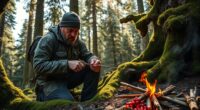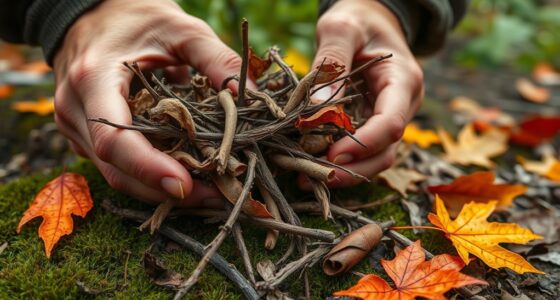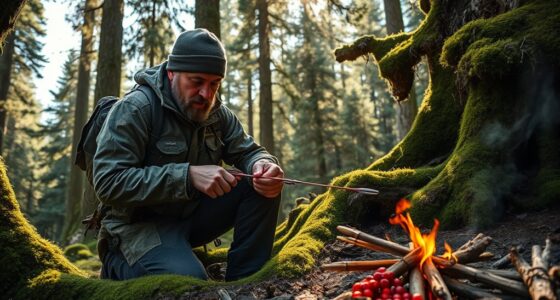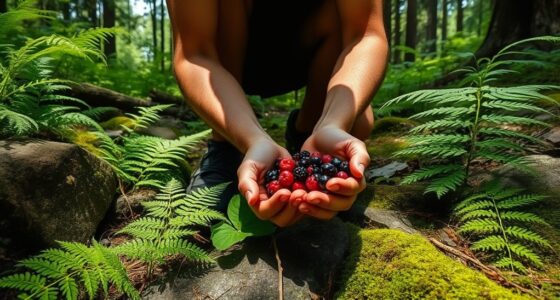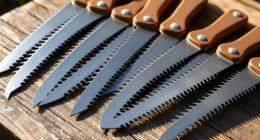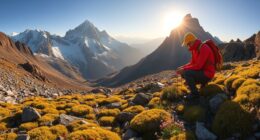When foraging along coastlines, focus on identifying edible plants, berries, and seaweeds by observing their features and growth patterns. Look for shellfish with smooth shells that close tightly and avoid those from polluted waters. Steer clear of toxic plants with milky sap or foul odors. Use simple tools for harvesting and learn effective preservation techniques; these skills help you gather safe, nourishing foods quickly. Keep exploring, and you’ll discover even more ways to gather and prepare coastal resources efficiently.
Key Takeaways
- Identify edible coastal plants and seaweeds by their appearance, avoiding toxic species with milky sap or foul odors.
- Use visual cues like shell tightness and cleanliness to select safe shellfish, avoiding polluted or encrusted shells.
- Rely on natural signs such as seabird activity and water color to locate edible marine life sources.
- Harvest roots, berries, and marine resources carefully, ensuring they are ripe, fresh, and free from mold or contamination.
- Preserve food through drying, salting, or smoking to extend shelf life and maintain nutrition during survival situations.
Recognizing Edible Plants and Seaweeds
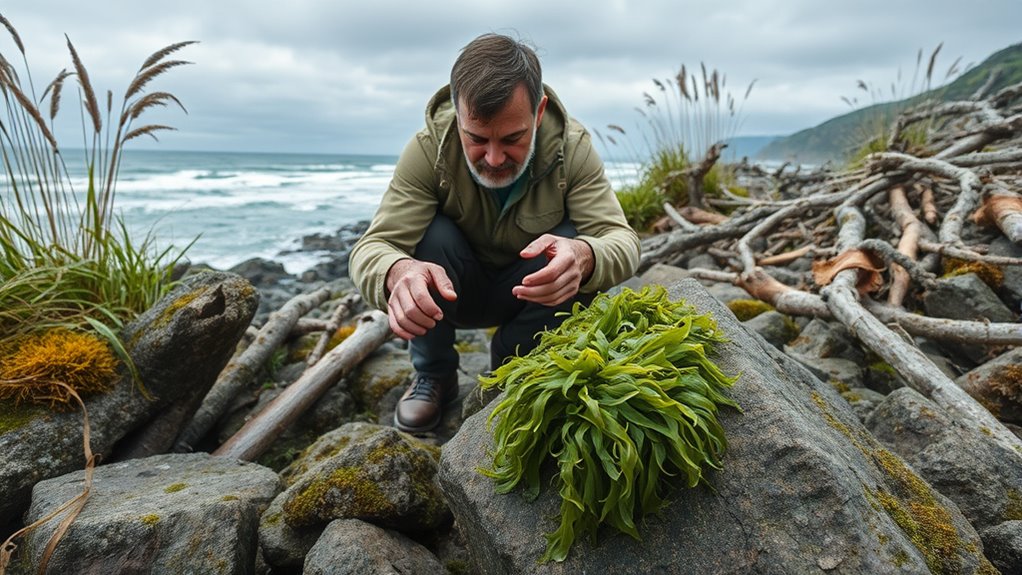
When foraging along coastal environments, accurately identifying edible plants and seaweeds is essential for safety and nourishment. You should focus on spotting edible roots, which often grow close to the surface or around plant bases—look for fibrous, firm roots without signs of rot or mold. Harvesting edible berries requires caution; ensure they’re ripe, vibrant, and free of mold or insects. Many coastal plants produce berries that are safe to eat, but some are toxic, so double-check identification. Pay attention to leaf shapes, growing patterns, and plant location. Avoid plants with milky sap, foul odor, or unusual coloration. Proper recognition prevents poisoning and guarantees you access to nourishing, safe foraged foods. Additionally, understanding the nutritional balance of foraged foods ensures you maintain energy and health during survival situations.
Identifying Safe Shellfish and Marine Life
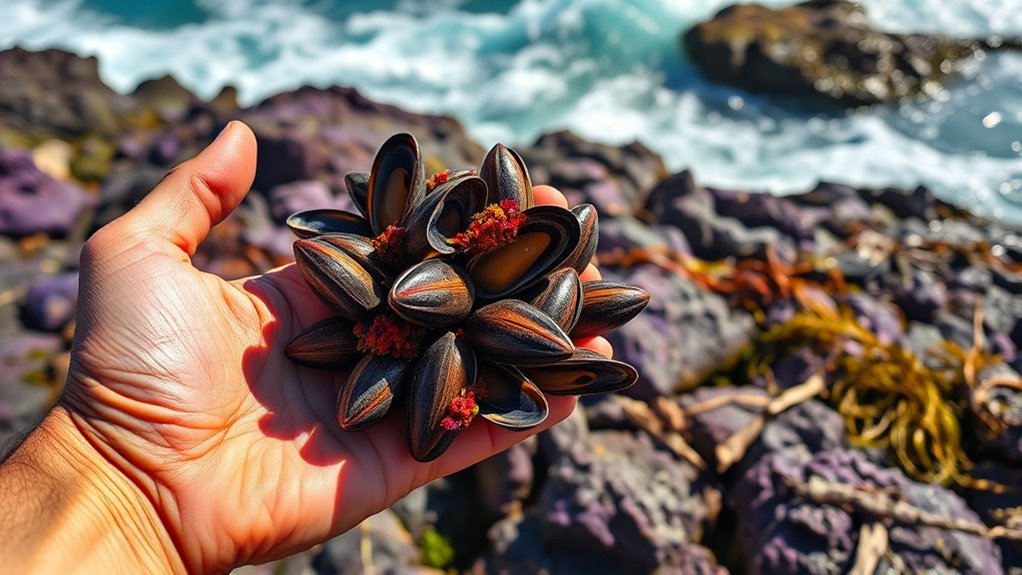
To safely harvest shellfish and marine life along coastal environments, you must learn to distinguish edible species from toxic ones. Proper shellfish identification is vital for marine safety, as many shellfish can carry toxins harmful to humans. Focus on identifying species with clear, smooth shells, and avoid those with irregular shapes, encrustations, or discolored markings. Look for signs of freshness, such as a tight shell closure when tapped. Avoid shellfish from polluted waters or areas near industrial sites. When collecting marine life, ensure it’s a species known to be safe for consumption, and always verify local guidelines. Accurate shellfish identification and knowledge of safe harvesting practices are essential to prevent poisoning and ensure your survival fishing efforts are effective and safe. Additionally, understanding environmental factors can help you avoid polluted waters, reducing the risk of contamination and ensuring healthier catch.
Avoiding Toxic Plants and Contaminated Water Sources

Avoiding toxic plants and contaminated water sources is essential for your safety during survival situations. Pollution hotspots along coasts often contain water contaminated with chemicals, bacteria, or heavy metals, making them unsafe to drink. Recognizing signs of plant toxicity is vital; avoid plants with bright colors, milky sap, or unusual odors, as these often indicate harmful substances. Be cautious near areas with visible pollution, such as oil spills or trash, since these indicate potential water contamination. Always seek out clear, flowing water or natural freshwater sources away from pollution hotspots. Remember, consuming toxic plants or contaminated water can lead to serious illness or dehydration, which can be life-threatening in survival scenarios. Prioritize safety by carefully evaluating your environment before foraging. Advances in real-time analytics help assess environmental risks more quickly, aiding your decision-making process in the field.
Tools and Techniques for Coastal Foraging

Equipped with the right tools and techniques, you can efficiently gather edible resources along the coast. Using simple harvesting techniques like hand picking or using a makeshift spear allows you to collect shellfish, crustaceans, and seaweed safely. Carrying a sturdy knife or prying tool helps with opening shells and harvesting larger marine life. Navigation strategies are essential; familiarize yourself with landmarks, tides, and currents to locate promising foraging spots. Tracking wave patterns and observing seabird activity can guide you to fruitful areas. Using natural indicators like algae or water color can also signal the presence of edible marine life. With these tools and techniques, you maximize your coastal foraging efficiency and minimize risks during your survival efforts.
Preparing and Preserving Coastal Food Resources
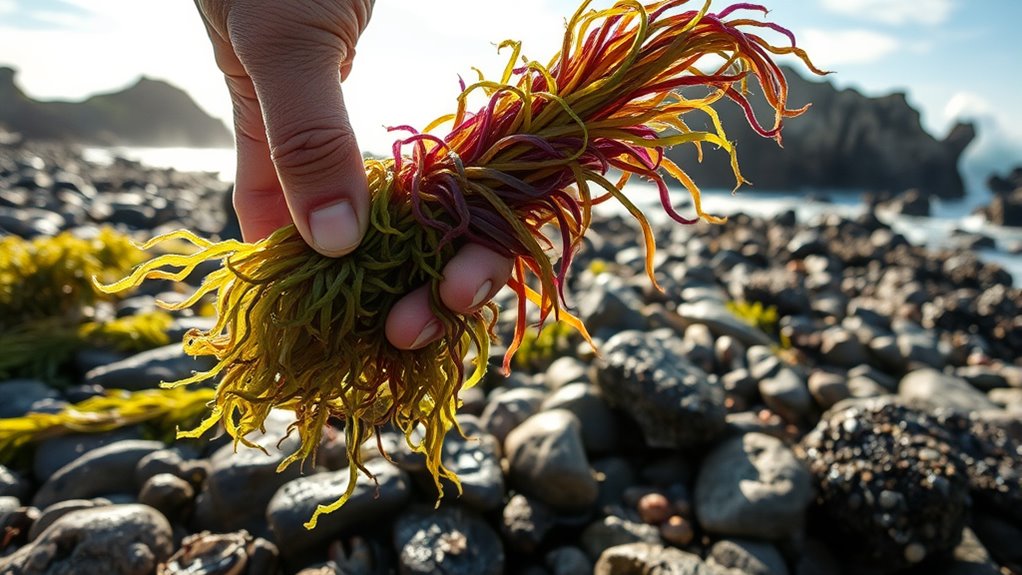
Once you’ve collected coastal food resources, preparing and preserving them promptly extends their edibility and prevents spoilage. To do this effectively, use simple methods like drying, salting, or smoking to preserve fish and shellfish. Proper drought management guarantees you conserve water during preparation, while shelter construction helps protect preserved foods from the elements. Using anti-aging ingredients in your preservation process can also help maintain the quality of your stored foods.
Frequently Asked Questions
How Do Tides Affect Foraging Opportunities Along the Coast?
Tides substantially impact your foraging opportunities by shaping tidal patterns and creating specific foraging windows. During low tide, you gain access to intertidal zones teeming with edible shellfish, seaweed, and other resources. Conversely, high tide covers these areas, limiting your options. By understanding the rhythm of tides, you can plan your foraging around these windows, maximizing your chances of gathering food efficiently and safely along the coast.
What Are Signs of Pollution or Contamination in Marine Environments?
You notice a stark contrast when spotting signs of pollution or contamination in marine environments. Clear water suddenly turns murky or discolored, and you see dead fish or oily films on the surface. These contamination indicators signal compromised water quality, alerting you to potential health risks. By observing unusual colors, foam, or strange odors, you can identify pollution signs early, helping you decide whether the area’s safe for foraging or if you should move on.
Can Certain Coastal Plants or Animals Cause Allergic Reactions?
Some coastal plants and animals can cause allergic reactions, so you should be cautious. Allergenic plants like certain marsh grasses or seaweeds might trigger skin irritation or respiratory issues. Marine allergens, such as shellfish or specific fish, can also lead to allergic responses if you’re sensitive. Always identify these species carefully and avoid contact if you’re prone to allergies. Knowing your environment helps protect you from unexpected allergic reactions while foraging or exploring coastal areas.
What Safety Precautions Should Be Taken When Handling Marine Creatures?
Handling marine creatures is like walking a tightrope over a stormy sea—danger lurks beneath the surface. You should always handle venomous species with utmost care, using proper tools like tongs or gloves to avoid direct contact. Stay alert for sharp spines or secretions, and never rush. Respect their power and stay cautious, because a single mistake can turn a calm tide into a dangerous whirlpool.
How Do Weather Changes Influence Coastal Foraging Safety?
Weather changes markedly impact coastal foraging safety. You should stay updated with weather forecasting to anticipate storms or rough seas. Sudden weather shifts can hinder marine navigation, making it dangerous to continue foraging. Strong winds and high waves increase the risk of accidents. Always plan your trip based on reliable weather data, and be prepared to leave if conditions deteriorate, ensuring your safety while gathering resources along the coast.
Conclusion
By mastering coastal foraging, you discover a treasure trove of survival skills that can keep you afloat in tough times. Recognize edible plants, seaweeds, and safe marine life while steering clear of dangers. With the right tools and techniques, you can turn nature’s bounty into nourishing meals and preserve them for later. Remember, knowledge is your best friend—don’t put all your eggs in one basket, stay prepared, and you’ll be ready to face whatever comes your way.

